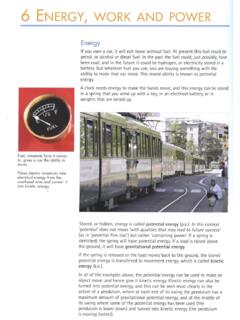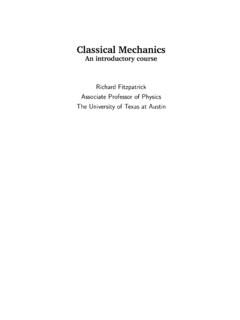Transcription of Chapter 4 – Homework Problems - Rose–Hulman Institute ...
1 4-69 A DAB C F E 50q 50q 15 in. 15 in. Chapter 4 Homework Problems problem When the power to an electric motor is turned on, the motor reaches its rated speed of 3300 rpm in 6 s, and when the power is turned off, the motor coasts to rest in 80 s. Assume uniformly accelerated motion. Determine the number of revolutions that the motor executes in a) reaching its rated speed, b) coasting to rest. problem Two blocks and a pulley are connected by inextensible cords as shown. The pulley has an initial angular velocity of Z = rad/s counterclockwise and a constant angular acceleration of D = rad/s2 clockwise. After 5 s of motion, determine the velocity and position of block A and block B. problem Three bars, each weighing 8 lbs, are welded together and are pin-connected to links BE and CF. The weight of the links can be neglected (this means that each link can be considered as a 2-force member, that is, the force acts along the link).
2 If the system is released from rest, determine the force in each link immediately after release. problem The uniform 60 lb log is supported by two cables and used as a battering ram. If the log is released from rest in the position shown, determine a) the tension in each cable immediately after release b) the corresponding angular acceleration of the cables. c) the tension in each cable when the cables are vertical. problem Puffy the cat is peacefully sitting on a chair as shown when her arch enemy Fido pulls on the rope as shown. Puffy weighs 8 lbs and the chair weighs 14 lbs. The centers of gravity of the cat, Gcat, and of the chair, Gchair are shown. Assume the wheels allow the chair to roll freely (that is no friction ). a) Determine the magnitude of the force in the rope so that the chair and cat are about to tip over (much to Fido s delight) assuming the cat does not move relative to the chair.
3 B) Determine the friction force between the cat and the chair assuming the coefficients of friction are Ps = and Pk = 90 mm 200 mmA B C 2 2 2 1 B C A 60 lb 60q 60q Gchair Gcat 32 in. 18 in. 8 in. 40q 45 in. 5 in. 4-70 A B 80 mm 60 mm A B w h1 P = 0 T F C h2 O problem Two blocks A and C are welded together and they rest on top of wedge B. Incline B has a weight, WB, block A has a weight, WA and block C has a weight, WC. The parameters, w, h1, h2, and T are all known. a) Assuming the friction between A and B is large enough to prevent sliding, determine the equations necessary to find the force, F, so that block A does not tip in a counterclockwise direction. b) Using w = , h1 = , h2 = , WA = 1 lbf, WB = 2 lbf, WC = lbf, and T=20 , determine a numerical value for F. c) Assuming F = 0 and the friction between block A and B is magically reduced to zero and block A does not tip, determine the velocity of block A and block B after A has moved a distance d=3 down the incline.
4 problem Disk A has a mass of 6 kg and an initial angular velocity of 360 rpm clockwise; disk B has a mass of 3 kg and is initially at rest. The disks are brought together by applying a horizontal force of magnitude 20 N to the axle of disk A. The coefficient of kinetic friction between the disks is Pk = Bearing friction can be neglected. Determine: a) the angular acceleration of each disk, b) the final angular velocity of each disk. problem A gear reduction system consists of three gears A, B, and C. Gear A starts from rest at time t = 0 and rotates clockwise with constant angular acceleration. Knowing that the angular velocity of gear A is 600 rpm at time t = 2 s, determine (a) the angular accelerations of gears B and C, (b) the accelerations of the points on gears B and C which are in contact when t = s. problem A bar is pinned at point O and a moveable mass is attached to it as shown.
5 The system is released from rest in the horizontal position and a sensor is attached to the top of the bar to measure its angular position. The system has the following nominal parameter values: mp = pendulum mass = g mw = moveable weight = 88 g Lp = pendulum length = cm ds = Sensor diameter = cm dw = moveable weight diameter = 5 cm Assuming the pendulum rod is mounted flush with the top of the sensor, and moveable weight is not moved lower than flush with bottom edge of pendulum rod, we would observe that. Lcg_min = minimum location for moveable mass = (ds+dw)/2 Lcg_max = maximum location for moveable mass = Lp - (ds+dw)/2 L_cg_pendulum =location of the pendulum center of gravity=(Lp-ds)/2 Determine: a) Plot the angular velocity of the pendulum when it is vertical as a function of the location of the moveable mass. b) Determine the location, Lcg, that will maximize the angular velocity when the bar is vertical.
6 150 mm 100 mm 50 mm A B C 50 mm 4-71 C 80 mm 120 mm A B weld v0 h b b A problem A slender 4 kg rod can rotate in a vertical plane about a pivot at B. A spring having a constant of k = 400 N/m and unstretched length of l = 150 mm is attached to the rod as shown. The rod is released from rest in the position shown. Determine: a) the angular velocity of the rod after it has rotated through 90q b) the reactions at point B after the rod has rotated through 90q problem A kg slender rod is welded to a 5 kg uniform disk as shown. The assembly swings freely about C in a vertical plane. In the position shown, the assembly has an angular velocity of Z = 10 rad/s clockwise. Determine a) the angular acceleration of the assembly, and b) the components of the reaction at C. problem (from Beer and Johnston 9th Ed.) The object ABC consists of two slender rods welded together at point B.
7 Rod AB has a mass of 1 kg and bar BC has a mass of 2 kg. Knowing the magnitude of the angular velocity of ABC is 10 rad/s when T = 0, determine the reactions at point C when T = 0. problem A slender rod of length l is pivoted about a point C located at a distance b form its center G. It is released from rest in a horizontal position and swings freely. Determine: a) The distance b for which the angular velocity of the rod as it passes through a vertical position is maximum b) Corresponding values of its angular velocity and of the reaction at C. problem A 45-g bullet is fired with a horizontal velocity of 400 m/s into a 9-kg panel of side b = m. Knowing that h = 190 mm and that the panel is initially at rest, determine a) the velocity of the center of the panel immediately after the bullet becomes imbedded, b) the impulsive reaction at A, assuming that the bullet becomes imbedded in 2 ms.
8 C) the reaction at A after the plate has swung through an angle of 90 degrees C 350 mm A B D 120 mm 600 mm k A B C m T m blACG B4-72 problem A 45-g bullet is fired with a velocity of 400 m/s into a 9-kg panel of side b = m as shown. Knowing that the bullet strikes the plate at a height h = 190 mm and that the panel is initially at rest, determine a) the velocity of the center of the panel immediately after the bullet becomes imbedded, b) the impulsive reaction at A, assuming that the bullet becomes imbedded in 2 ms. c) the reaction at A after the plate has swung through an angle of 90 degrees Note: For part c) neglect the mass of the bullet since you do not know exactly where it will become lodged in the plate. problem Two slender bars of length, L, are welded together with an angle of 120 between the bars as shown. The welded object is then pinned at B.
9 Each individual bar has a mass m and a mass moment of inertia of IG. A small glob of putty, D, of mass mD strikes the end C of member ABC with a velocity v0 and the putty sticks to the bar. a) Determine the equations necessary to find: x angular velocity of ABC immediately after impact x the reactions at B immediately after the impact You may assume the glob is a point mass. b) Assuming that v0 = m/s, m = kg, L = m, and mD = kg determine numerical answers to part a). problem (from Beer and Johnston 9th Ed.) A large 3-lb sphere with a radius r = 3 in. is thrown into a light basket at the end of a thin, uniform rod weighing 2 lb and length L = 10 in. as shown. Immediately before the impact the angular velocity of the rod is 3 rad/s counterclockwise and the velocity of the sphere is 2 ft/s down. Assume the sphere sticks in the basket. Determine after the impact (a) the angular velocity of the bar and sphere, (b) the components of the reactions at A.
10 problem A drum is rigidly attached to a drum as shown. One of the drums rolls without sliding on the surface shown, and a cord is wound around the other drum. End E of the cord is pulled to the left with a velocity of v = 6 in/s. Determine: a) angular velocity of the drums b) velocity of the center of the drums c) length of cord wound or unwound per second. problem At the instant shown, the angular velocity of rod AB is Z = 15 rad/s clockwise. Determine: a) Angular velocity of rod BD b)Velocity of the midpoint of rod BD 3 in. 5 in. mA D C B mv0 h b b A 30q v0 B A C D 60 60 L L 4-73 problem (from Beer and Johnston 9th Ed.) In the position shown, bar DE has a constant angular velocity of 10 rad/s clockwise. Knowing that h = 500 mm, determine (a) the angular velocity of bar FBD, (b) the velocity of point F. problem Rod BC (m = 5 kg) is attached by pins to two uniform disks as shown.










